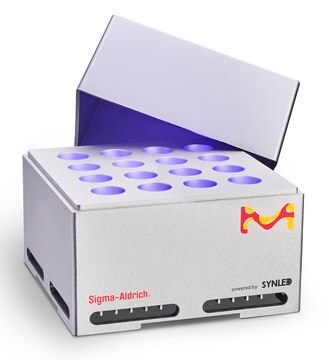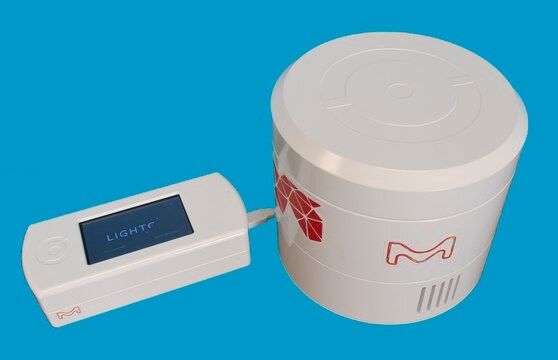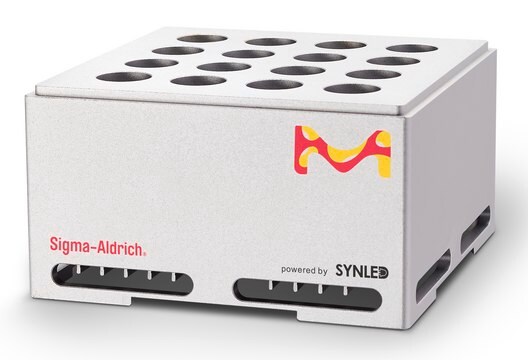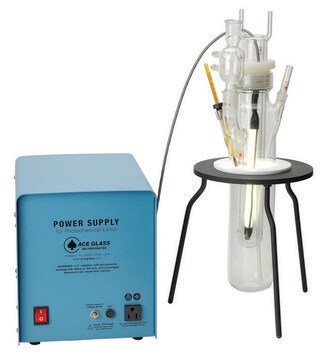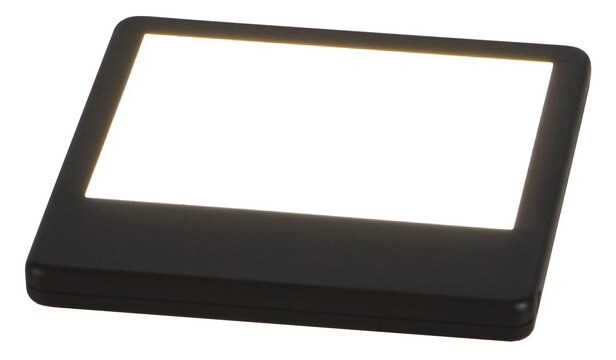Z744035
Penn PhD Photoreactor M2
Synonym(e):
photoreactor
About This Item
Empfohlene Produkte
Aufnahme AC/DC
100 - 240 V AC, 50/60 Hz
Leistungsmerkmale
thermocouple type K-Type Thermocouple
(Touch Screen: 3.5” TFT LCD; 320 x 480 resolution)
Eignung der Reaktion
reaction type: Photocatalysis
reagent type: catalyst
Parameter
(Variable stir bar control 100 - 2000 RPM)
0-95% RH at 10-40 °C
B × H × T
11.4 cm × 27.2 cm × 27.9 cm
4.5 in. × 10.7 in. × 11.0 in.
Versandbedingung
ambient
Allgemeine Beschreibung
Features and Benefits
- Modular design allows for use with a variety of wavelengths: 450 nm (included), 420 nm (sold separately), 395 nm (sold separately) and 365 nm (sold separately)
- 360 degree reflective environment maximizes surface area photon capture
- Light shield interlock prevents user exposure to harmful light rays
- Interactive touch screen controls reaction parameters
- Intertek ETL, CE, and CB approved
- User defined parameters including temperature, light intensity, fan speed and stirring
- Auto stop, pause and reset options
- Supports vial sizes gc, 4, 8, 20, 40 ml
- Multi-vial holders are available to allow four 8 mL vials and five 4 mL vials reactions to be run in parallel.
- Temp feedback using a k-type thermocouple
- Z744035-1EA-US: type B
- Z744035-1EA- IN: type D
- Z744035-1EA-EU-E: type E
- Z744035-1EA-EU-F: type F
- Z744035-1EA-UK: type G
- Z744035-1EA-CN: type I
- Z744035-1EA-CH: type J
Photocatalysis Technology Spotlight
Ähnliches Produkt
Hier finden Sie alle aktuellen Versionen:
Analysenzertifikate (COA)
Leider sind derzeit keine COAs für dieses Produkt online verfügbar.
Wenn Sie Hilfe benötigen, wenden Sie sich bitte an Kundensupport
Besitzen Sie dieses Produkt bereits?
In der Dokumentenbibliothek finden Sie die Dokumentation zu den Produkten, die Sie kürzlich erworben haben.
Kunden haben sich ebenfalls angesehen
Artikel
Photoredox catalysis is a powerful synthetic methodology to form challenging covalent bonds using light irradiation. It is effective for light-driven polymer and small molecule synthesis.
Csp2- and Csp-hybridized coupling reactions are established catalytic approaches. However, multi-step Csp3- and Csp2-coupling reactions of boronic acids and related derivatives are still limited by ineffective two-electron transmetalation reactions.
The application of radical chemistry towards organic synthesis is well-developed and wide-reaching, though often hampered by a dependence on toxic radical initiators.
While Markovnikov alkene reactivity is very well developed and utilized commonly in the synthesis of commodity and research chemicals, catalytic access to the anti-Markovnikov-selective adducts is a much less-developed endeavor.
Unser Team von Wissenschaftlern verfügt über Erfahrung in allen Forschungsbereichen einschließlich Life Science, Materialwissenschaften, chemischer Synthese, Chromatographie, Analytik und vielen mehr..
Setzen Sie sich mit dem technischen Dienst in Verbindung.

